
| Ernst U. von Weizsaecker |
 |
|
 |
 |
 |
|
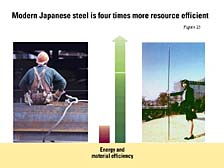
figure 26
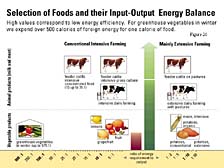
figure 27
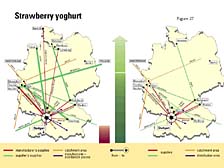
figure 28
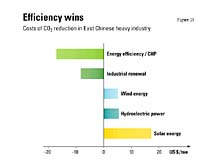
figure 29
 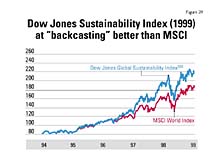
figure 30
|
Figure 26
Steel has been a fairly clumsy kind of material. I was learning from Ryoichi Yamamoto.
Ryoichi Yamamoto visited Dusseldorf, Germany, in May and he gave me a number of
nice pictures of modern Japanese steel being at least a factor of 4 better in
resource productivity than conventional steel.
Figure 27
If you eat winter tomatoes from greenhouses in Holland today, for
each Kcal that you put into your mouth some 100 Kcal have been invested
beforehand. It's a huge waste of energy. A fairly similar story
can be told about feeder cattle, and if you compare that with essentially
organic farming you end up with at least a factor of 4 better. In
the case of vegetables it is a factor of 100.
Figure 28
Stefanie Boge at the Wuppertal Institute once studied the transport
intensity of manufacturing strawberry yogurt in Germany and ended
up finding that for each cup of strawberry yogurt lorried across
central Europe, roughly 8,000 kilometers are driven by these lorries
to end up finally with a cup of strawberry yogurt on one's table.
Evidently, you can do at least four times better.
I believe this is more or less the entire story that I wanted to
show you. Clearly, not only strawberry yogurt journeys can be rationalized.
Many business trips can be saved using videoconferences, and letters
and manuscripts don't always need airmail from Japan to Europe.
Much can be sent by e-mail, saving a factor of 100 or 1,000 in resource
use. I am fully aware that substituting electronic dispatch for
air transport is a bit difficult in the case of tourism or award
ceremonies. Besides, people like coming to Tokyo from overseas and
do not want to miss seeing each other, so I'm aware there are always
problems of additional journeys stimulated by electronic use of
e-mail or videoconferences.
There is another important factor 4 chapter to be added, namely
total material recycling. No ton of metals or plastic or glass that
goes into manufacturing should ever end up in waste bins. This,
I understand, is one of the philosophies being developed by Bio
and by METI, and I'm very happy to say that people are listening
very attentively in Germany to what is happening in Japan with your
new Recycling Law. I'm sorry to admit that the German Recycling
Law, heralded as opening a new age of reuse and recycling of materials,
is not living up to its expectations.
After having sketched out to you perhaps the shape of that new universe
of factor 4 or 10 technologies, I should like to turn to some economic
and political questions. What can we do to make this technology
shift profitable? Fortunately, a reasonable part of the eco-efficiency
measures are already profitable, and this is particularly true in
developing countries.
Figure 29
During my last journey to China, I saw a brochure on the question
of how much money you will have to spend for reducing carbon dioxide
by one ton. I already found it quite a good message - quite a good
surprise for me that solar energy would make it so cheap, less than
20 US dollars per ton. But this is still, of course, much too much
for the Chinese economy.
Figure 30
So perhaps the best advice the Chinese are taking with regard to
carbon dioxide reduction is industrial renewal. It's simply modernization
as we have done in East Germany, but there is one option that is
still better. It is energy efficiency and combined heat and power.
There, for each ton of carbon dioxide reduced, you earn 20 dollars.
You become richer by 20 dollars, so this is eco-efficiency that
is already profitable. But it is only one segment. In many regards,
as Bio has quite clearly said, the increase of resource productivity
or the decrease of resource intensity is not profitable yet. Nevertheless,
all in all, it seems that the sustainable development stocks fare
better on stock markets than the international benchmark index -
the Morgan Stanley Capital International.
Let me go a few steps further. This is, of course, an encouraging
piece of news, but we can go still further, namely in the Netherlands,
as an example, investments in green portfolios enjoy a tax advantage
over ordinary funds, and this serves as an important signal to the
capital markets and leads to a situation in which ecological start-up
firms find it much easier to access capital from the capital markets.
It can be seen as a perfectly legitimate objective for the state
and for the international community to create an atmosphere that
is favorable for redirecting technological progress. |
|
|